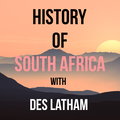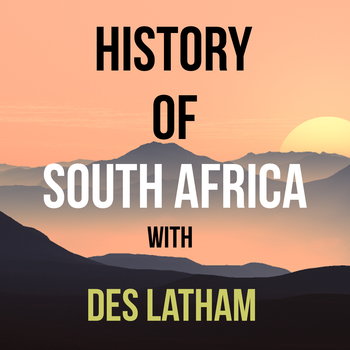
Episode 135 - The Zulu army overruns the Voortrekkers along the Bloukrans and Bushman’s River
Loading player...
As you heard, Piet Retief and 100 Boers and Khoesan agterryes had been killed by Dingana on the 6th February 1838.
Missionary Owen watched the killings through his telescope until he couldn’t take it any more and collapsed in shock.
The Zulu king was not done, he’d ordered his amabutho warriors to seek and destroy the Voortrekkers who’d camped along the rivers below the Drakensberg where they’d arrived in large numbers expecting Retief’s negotiations to have ended well. Retief had thought so too, particularly after he’d returned Dingana’s cattle rustled by Sekhonyela of the baTlokwa.
About a thousand wagons had descended the passes, and the Zulu were determined the Voortrekkers were not going to remain on the land they’d invaded.
The vultures, wild dogs, and hyenas, jackals began to feed on the bodies strewn about kwaMatiwane near emGungungdlovu where Retief’s men had met their grisly end, while Owen and his family trembled with fear nearby.
Were they going to be next they wondered.
Dingana had sent a message as Retief was killed saying their were safe, but who believed the AmaZulu leader about anything?
Meanwhile, some of the warriors were going through the Boers baggage and inspecting the muskets that had been piled outside the main gate. Puffs of dust appeared from the south, and from there two horseman and their small travel party appeared at emGungundlovu.
Talk about bad timing.
It was James Brownlee who was a very young translator and a trainee missionary, and the American Henry Venables. They had picked a particularly bad time to ride up to Dingana’s Great Place.
From a Zulu perspective, Dingana’s orders for his amabutho to kill the Voortrekkers was a matter of business as usual, this was the normal way of things when a chief was disgraced and executed. His family and adherents would be bumped off, or “eaten up” to use the Zulu phrase, so that there would be none alive to avenge the king.
The Voortrekker livestock would be seized and the king would redistribute these beasts amongst his amabutho, exactly as the Boers had been doing amongst their Kommando members after the raids on Mzilikazi. And like the Boer raids on Mzilikazi, very few women or children were to be spared by Zulu warriors.
The Zulu army of about 5000 crossed a famous river at a famous point, the Mzinyathi or Buffalo River near Rorke’s Drift. How ironic that 42 years later, the very same crossing would see English soldiers fleeing from Cetswayo’s warriors after the Battle of Isandhlwana hunted across this very same Drift.
So the 5000 warriors marched along the Helpmekaar heights towards the Thukela River close to the confluence with the Bloukrans through the second week of February 1838.
By now most of the trekkers had scattered through this territory, in little family encampments of three or four wagons over a large area. Only a few had taken the English traders warning seriously and established defensible wagon laagers.
Most did not, they just outspanned where they were and began enjoying the fruits of the veld.
Many of these had headed off on hunts, leaving their families alone with their Khoesan servants, and to them, the AmaZulu warriors were going to do what the amaNdebele had done in August 1836.
Fall upon the wagons and kill everyone they could find.
Missionary Owen watched the killings through his telescope until he couldn’t take it any more and collapsed in shock.
The Zulu king was not done, he’d ordered his amabutho warriors to seek and destroy the Voortrekkers who’d camped along the rivers below the Drakensberg where they’d arrived in large numbers expecting Retief’s negotiations to have ended well. Retief had thought so too, particularly after he’d returned Dingana’s cattle rustled by Sekhonyela of the baTlokwa.
About a thousand wagons had descended the passes, and the Zulu were determined the Voortrekkers were not going to remain on the land they’d invaded.
The vultures, wild dogs, and hyenas, jackals began to feed on the bodies strewn about kwaMatiwane near emGungungdlovu where Retief’s men had met their grisly end, while Owen and his family trembled with fear nearby.
Were they going to be next they wondered.
Dingana had sent a message as Retief was killed saying their were safe, but who believed the AmaZulu leader about anything?
Meanwhile, some of the warriors were going through the Boers baggage and inspecting the muskets that had been piled outside the main gate. Puffs of dust appeared from the south, and from there two horseman and their small travel party appeared at emGungundlovu.
Talk about bad timing.
It was James Brownlee who was a very young translator and a trainee missionary, and the American Henry Venables. They had picked a particularly bad time to ride up to Dingana’s Great Place.
From a Zulu perspective, Dingana’s orders for his amabutho to kill the Voortrekkers was a matter of business as usual, this was the normal way of things when a chief was disgraced and executed. His family and adherents would be bumped off, or “eaten up” to use the Zulu phrase, so that there would be none alive to avenge the king.
The Voortrekker livestock would be seized and the king would redistribute these beasts amongst his amabutho, exactly as the Boers had been doing amongst their Kommando members after the raids on Mzilikazi. And like the Boer raids on Mzilikazi, very few women or children were to be spared by Zulu warriors.
The Zulu army of about 5000 crossed a famous river at a famous point, the Mzinyathi or Buffalo River near Rorke’s Drift. How ironic that 42 years later, the very same crossing would see English soldiers fleeing from Cetswayo’s warriors after the Battle of Isandhlwana hunted across this very same Drift.
So the 5000 warriors marched along the Helpmekaar heights towards the Thukela River close to the confluence with the Bloukrans through the second week of February 1838.
By now most of the trekkers had scattered through this territory, in little family encampments of three or four wagons over a large area. Only a few had taken the English traders warning seriously and established defensible wagon laagers.
Most did not, they just outspanned where they were and began enjoying the fruits of the veld.
Many of these had headed off on hunts, leaving their families alone with their Khoesan servants, and to them, the AmaZulu warriors were going to do what the amaNdebele had done in August 1836.
Fall upon the wagons and kill everyone they could find.

